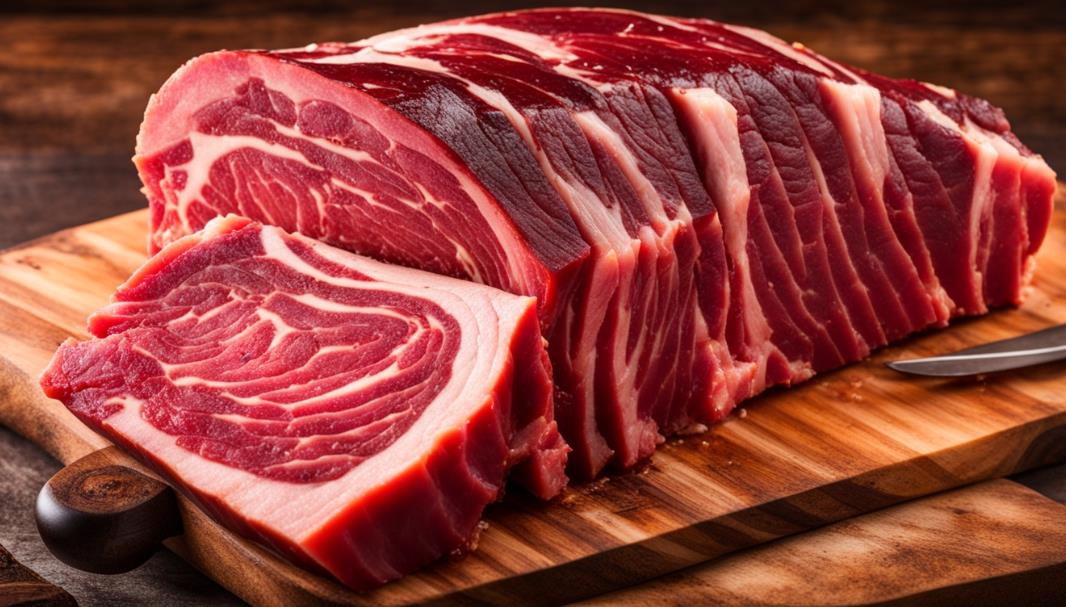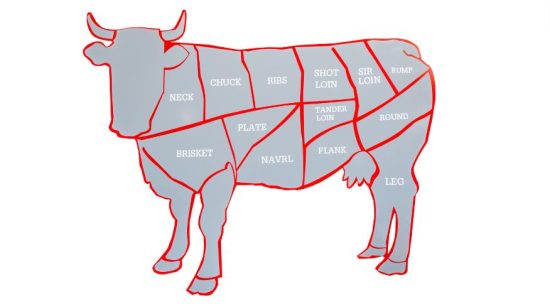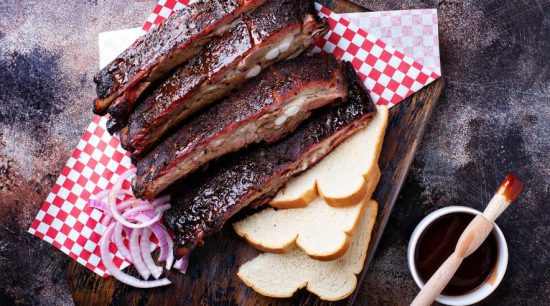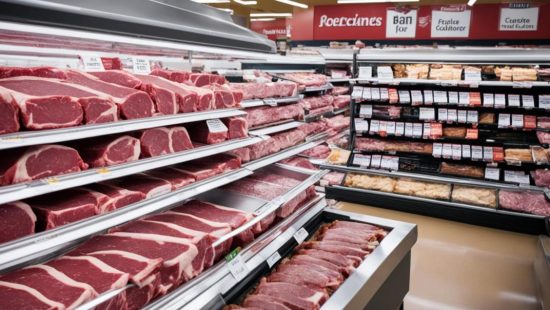What Part of the Cow is Brisket? A Guide to This Cut
Discover what part of the cow is brisket and why this beloved cut stands out in BBQ and culinary circles. Unravel the mystery of brisket here.

Did you know that the brisket cut of beef can account for up to 8% of the total weight of a cow? That’s a significant portion! If you’ve ever wondered where brisket comes from on the cow and how to make the most of this flavorful cut, you’ve come to the right place.
Let’s explore the location of brisket on the cow and provide valuable information on this versatile cut. Whether you’re a barbecue enthusiast looking to perfect your smoking techniques or someone looking to expand their culinary repertoire, understanding the ins and outs of brisket is essential. So let’s dig deeper into the world of brisket and discover why it has become such a beloved cut of beef in BBQ and culinary circles.
Understanding Brisket and Its Place on the Cow

Now we will delve deeper into the details of brisket and its place on the cow. We will discuss the specific location of brisket and its unique muscular structure. Additionally, we will explore the important role of connective tissues in brisket and how they contribute to its tenderness and flavor. Finally, we will highlight popular cooking methods for brisket, including smoking, braising, and grilling.
Brisket’s Location and Muscular Structure
Brisket is a cut of beef that comes from the lower chest area of the cow. It is specifically found between the forelegs, attached to the breastbone. This location provides the brisket with a unique combination of muscles and connective tissues.
The muscular structure of brisket consists of two main parts: the point and the flat. The point, also known as the deckle, is a heavily marbled section that sits on top of the flat. It contains more fat, which contributes to its tenderness and rich flavor. The flat, on the other hand, is a leaner and larger portion of the brisket. Both the point and the flat offer distinct textures and flavors, making them versatile for various cooking techniques.
The Role of Connective Tissues in Brisket
Connective tissues play a crucial role in the structure of brisket and its tenderness when cooked properly. Brisket contains a significant amount of collagen, a type of connective tissue, which breaks down during the cooking process. As the collagen breaks down, it transforms into gelatin, resulting in a tender and moist final product.
This high collagen content makes brisket an ideal cut for slow-cooking methods, allowing for ample time to break down the tough connective tissues and develop a melt-in-your-mouth texture.
Popular Cooking Methods for Brisket

There are several popular cooking methods for brisket that bring out its unique flavors and textures.
- Smoking is a favored technique for brisket, especially in BBQ circles. The low and slow cooking process over indirect heat infuses the meat with a smoky flavor, while the gentle heat helps break down the connective tissues. This method results in tender, flavorful brisket with a distinctive smoke ring.
- Braising involves cooking brisket slowly in a flavorful liquid, such as broth or wine, in a covered pot or Dutch oven. This method helps tenderize the meat while adding additional flavors. The result is a juicy, fork-tender brisket.
- Grilling is a popular method for cooking brisket, particularly for thinner cuts. It involves high heat cooking over direct heat for a shorter duration. This technique is ideal for smaller portions, such as brisket steaks, and requires careful attention to prevent overcooking.
What Part of the Cow is Brisket?
Brisket, a highly regarded cut of beef in BBQ and culinary circles, comes from the lower chest area of the cow. This flavorful and versatile cut is located between the forelegs, extending from the bottom of the neck to the top of the abdomen.
The brisket is composed of two main muscles: the point and the flat. The point, also known as the deckle or the fatty end, is located closer to the front of the cow and contains more marbling, which contributes to its rich flavor. The flat, also known as the first cut or the lean end, is a larger and leaner muscle that is located toward the back of the cow.
As a prized cut of beef, brisket offers a balance of tenderness and flavor that makes it ideal for various cooking methods. Its location on the cow and the unique combination of muscles and connective tissues result in a cut that can be transformed into succulent and delicious dishes.
The Anatomy of a Brisket: Point, Flat, and Decker Cuts
In order to fully understand the complexity and versatility of a brisket, it’s important to explore its anatomy. A brisket is divided into three distinct cuts: the point, the flat, and the decker. Each cut has its own characteristics that contribute to the overall flavor and texture of the meat.
The point cut, also known as the deckle or the fatty side, is located on the top of the brisket. It is well-marbled with fat, which gives it a rich and juicy flavor. The point cut is often used for making burnt ends, a delectable BBQ delicacy known for its caramelized crust and tender interior. The flat cut, also referred to as the first cut or the lean side, is situated below the point. It is a leaner cut of meat with less fat marbling. The flat is known for its tenderness and is commonly used for slicing thin for sandwiches or serving as the main centerpiece of a meal.
The decker cut, also called the second cut or the hardoy, is a less commonly used portion of the brisket. It is found below the flat and carries a higher fat content compared to the other cuts. The decker cut can add extra richness and juiciness to dishes when incorporated into stews, soups, or ground beef. Understanding the different cuts of a brisket allows you to choose the perfect cut based on your desired dish and cooking method. Whether you’re looking for a tender, lean cut or a flavorful, well-marbled option, the anatomy of a brisket provides a range of possibilities to suit your culinary preferences.
Why is Brisket So Expensive and Highly Valued?
Brisket is known for its relatively high price compared to other cuts of beef. This can be attributed to several key factors that influence its cost. Brisket’s rise in popularity, especially in the BBQ and culinary communities, has contributed to its increased demand and subsequently higher price. As more people seek out and appreciate the unique flavors and tenderness of brisket, the demand continues to grow.
The production process of brisket involves several labor-intensive steps, such as trimming and preparing the cut for cooking. Additionally, the extended cooking time required to achieve the desired tenderness further increases the cost of brisket production. Brisket that is of higher quality and grade will naturally command a higher price. Factors such as marbling, tenderness, and overall flavor contribute to the grading and pricing of brisket.
Fluctuations in the beef market, including factors such as supply and demand, can impact the cost of brisket. When the supply of brisket is limited or there is increased demand, the price tends to rise accordingly.
Comparison with Other Cuts
When comparing the cost of brisket with other cuts of beef, it’s important to consider the factors mentioned above. While brisket may be more expensive than some cuts, its unique flavor and tenderness make it highly valued by meat enthusiasts and BBQ aficionados. When cooked properly, brisket delivers an unparalleled eating experience, making it worth the investment for many.
Compared to leaner cuts like sirloin or tenderloin, brisket offers a fattier and more flavorful profile. This richness comes from the marbling and connective tissues present, which break down during the cooking process and create melt-in-your-mouth results. Other cuts may have their own merits, but the distinct qualities of brisket set it apart.
Brisket in the Grocery Store: Navigating Names and Labels
Purchasing brisket from a grocery store can be confusing due to different names and labeling practices. When you walk down the meat aisle, you may come across various names that refer to brisket. To ensure you make the right choice, it’s essential to understand these alternative names for brisket.
What is Another Name for Brisket?

Another name for brisket is “brisket flat.” This cut is often labeled as “flat cut brisket” or “first cut brisket” in grocery stores. It refers to the leaner portion of the brisket, which is typically used for slicing and is popular in dishes like sandwiches or corned beef. Another alternative name for brisket is “whole packer cut.” This refers to the entire brisket, which includes both the point and the flat cuts. The whole packer cut is commonly used for smoking and slow cooking.
Understanding Meat Labels and Grades
When purchasing brisket, it’s important to pay attention to the meat labels and grades. These labels provide information about the quality and characteristics of the brisket. Here are some common meat labels and grades you may encounter:
- USDA Choice indicates high-quality beef that has a good amount of marbling, which enhances flavor and tenderness. It is a popular choice for brisket.
- USDA Select represents a lower level of marbling compared to USDA Choice. While it may still be suitable for cooking, USDA Choice is often preferred for brisket.
- Prime grade is the highest quality grade for beef. It has abundant marbling and is known for its exceptional tenderness and flavor. However, it can be expensive and less commonly found in grocery stores.
- Certified Angus Beef is a brand-specific label that guarantees certain quality standards for the beef. Certified Angus Beef brisket is known for its consistent marbling, tenderness, and flavor.
Understanding these meat labels and grades can help you make informed decisions when selecting brisket at the grocery store. It’s important to consider your personal preferences, cooking method, and budget when choosing the right grade for your needs.
Healthy Eating: Analyzing Brisket’s Nutritional Profile
While indulging in the rich and flavorful taste of brisket is a delight, it is essential to understand the nutritional profile of this beloved cut of beef. Analyzing the brisket’s nutritional content can help you make informed dietary choices and incorporate it into a balanced meal plan.
Brisket is a good source of protein, essential for repairing and building tissues in your body. A three-ounce serving of brisket provides an average of 23 grams of protein, making it a valuable addition to your protein intake.
However, it is important to note that brisket is also relatively high in fat content. A three-ounce serving typically contains about 18 grams of fat, including both saturated and unsaturated fats. While it adds to the rich flavor and tenderness of the meat, it is essential to consume brisket in moderation to maintain a healthy diet. Additionally, brisket is a calorie-dense cut of beef. A three-ounce serving can contain around 294 calories, mainly derived from the fat content. If you are watching your calorie intake, it is crucial to consider portion sizes and balance them with other nutrient-dense foods.
Despite its higher fat and calorie content, brisket does offer health benefits when consumed as part of a well-rounded diet. It provides essential vitamins and minerals, including iron, zinc, and B vitamins, which contribute to overall health and well-being. When enjoying brisket, consider pairing it with healthier sides and incorporating additional nutrient-rich foods into your meals. Opt for a variety of colorful vegetables, whole grains, and lean protein sources to create a balanced plate that contributes to your overall health.
Cheap Alternatives to Brisket: Savvy Shopping for Similar Cuts
While brisket is a beloved cut of beef, its higher price point can sometimes make it less accessible to budget-conscious consumers. However, there are several economical alternatives to brisket that offer similar flavors and textures, allowing you to enjoy delicious meals without breaking the bank.
One option to consider is chuck roast, which is a cut from the shoulder of the cow. It shares many similarities with brisket, including its rich marbling and tenderness when cooked low and slow. Another affordable alternative is beef shank, obtained from the leg of the cow. This cut offers a deep, beefy flavor and becomes incredibly tender when braised or slow-cooked.
If you’re looking specifically for a leaner option, top round roast can be an excellent choice. It is a lean and versatile cut that can be used in various recipes, including roasts and stews. Additionally, short ribs, although meatier and fattier than brisket, can provide a similar depth of flavor, especially when slow-cooked to achieve melt-in-your-mouth tenderness.
When shopping for these alternatives, keep in mind that different cuts may require different cooking methods. For instance, chuck roast and beef shank benefit from low and slow cooking techniques, such as braising or slow-roasting. Top round roast, on the other hand, is more suited for oven roasting or grilling to medium-rare. By understanding the characteristics and ideal cooking methods for each alternative, you can make informed decisions and create satisfying meals without overspending.
FAQs on What part of the cow is brisket
Is brisket a lean cut of meat?
No, brisket is not a lean cut. It contains a significant amount of connective tissue and fat, which contribute to its rich flavor and texture when cooked properly.
How should brisket be cooked?
Brisket is best cooked slowly using low-temperature methods such as smoking, braising, or slow roasting to break down its tough connective tissues and render it tender and flavorful.
What dishes can be made with brisket?
Brisket is a versatile cut of meat that can be used in various dishes, including traditional barbecue, Texas-style smoked brisket, braised brisket with vegetables, brisket sandwiches, and more.
Can brisket be frozen?
Yes, brisket can be frozen for future use. It’s best to wrap it tightly in plastic wrap or aluminum foil and then place it in an airtight container or freezer bag to prevent freezer burn.








